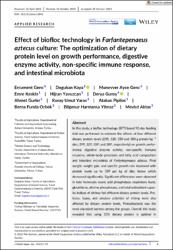| dc.contributor.author | Genç, Ercüment | |
| dc.contributor.author | Kaya, Doğukan | |
| dc.contributor.author | Genç, Münevver Ayçe | |
| dc.contributor.author | Keskin, Emre | |
| dc.contributor.author | Yavuzcan, Hijran | |
| dc.contributor.author | Güroy, Derya | |
| dc.contributor.author | Gürler, Ahmet | |
| dc.contributor.author | Yaraş, Koray Umut | |
| dc.contributor.author | Pipilos, Atakan | |
| dc.contributor.author | Özbek, Berna Funda | |
| dc.contributor.author | Yılmaz, Bilgenur Harmansa | |
| dc.contributor.author | Aktaş, Mevlüt | |
| dc.date.accessioned | 2024-01-17T10:52:02Z | |
| dc.date.available | 2024-01-17T10:52:02Z | |
| dc.date.issued | 2023 | en_US |
| dc.identifier.citation | Genc, E., Kaya, D., Genc, M.A., Keskin, E., Yavuzcan, H., Guroy, D., Gurler, A., Yaras, K.U., Pipilos,
A., Ozbek, B.F., Yilmaz, B.H., Aktas, M. (2023). Effect of biofloc technology in Farfantepenaeus aztecus culture: The optimization of dietary protein level on growth performance, digestive enzyme activity, non-specific immune response, and intestinal
microbiota. Journal of the World Aquaculture Society.
https://doi.org/10.1111/jwas.13041 | en_US |
| dc.identifier.uri | https://doi.org/10.1111/jwas.13041 | |
| dc.identifier.uri | https://hdl.handle.net/20.500.12508/3023 | |
| dc.description.abstract | In this study, a biofloc technology (BFT) based 90-day feeding trial was performed to estimate the effects of four different dietary protein levels (290, 320, 350 and 380 g protein kg(-1) diet; 29P, 32P, 35P, and 38P, respectively) on growth performance, digestive enzyme activity, non-specific immune response, whole-body proximate and fatty acid composition and intestinal microbiota of Farfantepenaeus aztecus. Final weight, weight gain, and specific growth rate improved with protein levels up to 35P per kg of diet, below which decreased significantly. Significant differences were observed in total hemocyte count, acid phosphatase, respiratory burst, glutathione, alkaline phosphatase, and total antioxidant capacity indices of shrimp fed different dietary protein levels. Protease, lipase, and amylase activities of shrimp were also affected by dietary protein levels. Proteobacteria was the most abundant bacteria among the groups. Overall, this study revealed that using 35% dietary protein is optimal in F. aztecus culture under environmentally friendly BFT conditions. Furthermore, these results provide a theoretical basis for future research on the evaluation of functional ingredients in diet for more economical production of F. aztecus at optimal protein levels. | en_US |
| dc.language.iso | eng | en_US |
| dc.publisher | Wiley | en_US |
| dc.relation.isversionof | 10.1111/jwas.13041 | en_US |
| dc.rights | info:eu-repo/semantics/openAccess | en_US |
| dc.subject | Dietary protein | en_US |
| dc.subject | Digestive enzyme activity | en_US |
| dc.subject | Immune response | en_US |
| dc.subject | Microbiota | en_US |
| dc.subject | Shrimp culture | en_US |
| dc.subject.classification | Fisheries | |
| dc.subject.classification | Biofloc Technology | |
| dc.subject.classification | Penaeus Vannamei | |
| dc.subject.classification | Aquaculture | |
| dc.subject.other | Litopenaeus-vannamei boone | |
| dc.subject.other | White-leg shrimp | |
| dc.subject.other | Gut microbiome | |
| dc.subject.other | Generation | |
| dc.subject.other | Resistance | |
| dc.subject.other | Density | |
| dc.subject.other | System | |
| dc.title | Effect of biofloc technology in Farfantepenaeus aztecus culture: The optimization of dietary protein level on growth performance, digestive enzyme activity, non-specific immune response, and intestinal microbiota | en_US |
| dc.type | article | en_US |
| dc.relation.journal | Journal of the World Aquaculture Society | en_US |
| dc.contributor.department | Deniz Bilimleri ve Teknolojisi Fakültesi -- Su Ürünleri Yetiştiriciliği Bölümü | en_US |
| dc.relation.publicationcategory | Makale - Uluslararası Hakemli Dergi - Kurum Öğretim Elemanı | en_US |
| dc.contributor.isteauthor | Genç, Münevver Ayçe | |
| dc.contributor.isteauthor | Yaraş, Koray Umut | |
| dc.contributor.isteauthor | Özbek, Berna Funda | |
| dc.contributor.isteauthor | Aktaş, Mevlüt | |
| dc.relation.index | Web of Science (SCI) - Scopus | en_US |
| dc.relation.index | Web of Science Core Collection - Science Citation Index Expanded | |
















